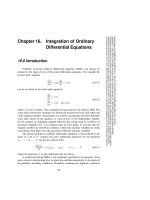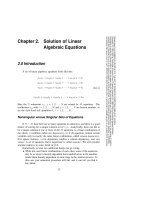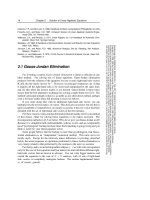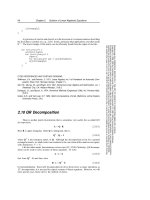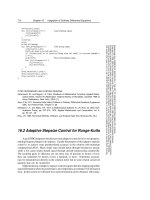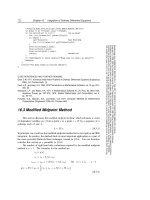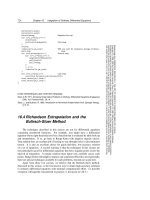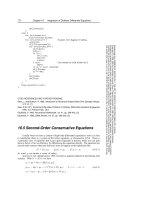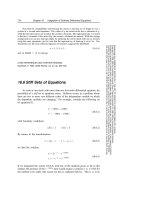galois theory of linear differential equations - m. van der put, m. singer
Bạn đang xem bản rút gọn của tài liệu. Xem và tải ngay bản đầy đủ của tài liệu tại đây (3.28 MB, 478 trang )
Galois Theory of Linear
Differential Equations
Marius van der Put
Department of Mathematics
University of Groningen
P.O.Box 800
9700 AV Groningen
The Netherlands
MichaelF.Singer
Department of Mathematics
North Carolina State University
Box 8205
Raleigh, N.C. 27695-8205
USA
July 2002
ii
Preface
This book is an introduction to the algebraic, algorithmic and analytic aspects
of the Galois theory of homogeneous linear differential equations. Although the
Galois theory has its origins in the 19
th
Century and was put on a firm footing
by Kolchin in the middle of the 20
th
Century, it has experienced a burst of
activity in the last 30 years. In this book we present many of the recent results
and new approaches to this classical field. We have attempted to make this
subject accessible to anyone with a background in algebra and analysis at the
level of a first year graduate student. Our hope is that this book will prepare
and entice the reader to delve further.
In this preface we will describe the contents of this book. Various researchers
are responsible for the results described here. We will not attempt to give
proper attributions here but refer the reader to each of the individual chapters
for appropriate bibliographic references.
The Galois theory of linear differential equations (which we shall refer to simply
as differential Galois theory) is the analogue for linear differential equations of
the classical Galois theory for polynomial equations. The natural analogue of a
field in our context is the notion of a differential field. This is a field k together
with a derivation ∂ : k → k, that is, an additive map that satisfies ∂(ab)=
∂(a)b + a∂(b) for all a, b ∈ k (we will usually denote ∂a for a ∈ k as a
). Except
for Chapter 13, all differential fields will be of characteristic zero. A linear
differential equation is an equation of the form ∂Y = AY where A is an n × n
matrix with entries in k although sometimes we shall also consider scalar linear
differential equations L(y)=∂
n
y + a
n−1
∂
n−1
y + ···+ a
0
y = 0 (these objects
are in general equivalent, as we show in Chapter 2). One has the notion of a
“splitting field”, the Picard-Vessiot extension, which contains “all” solutions of
L(y) = 0 and in this case has the additional structure of being a differential field.
The differential Galois group is the group of field automorphisms of the Picard-
Vessiot field fixing the base field and commuting with the derivation. Although
defined abstractly, this group can be easily represented as a group of matrices
and has the structure of a linear algebraic group, that is, it is a group of invertible
matrices defined by the vanishing of a set of polynomials on the entries of these
matrices. There is a Galois correspondence identifying differential subfields with
iii
iv PREFACE
linear algebraic subgroups of the Galois group. Corresponding to the notion of
solvability by radicals for polynomial equations is the notion of solvability in
terms of integrals, exponentials and algebraics, that is, solvable in terms of
liouvillian functions and one can characterize this in terms of the differential
Galois group as well.
Chapter 1 presents these basic facts. The main tools come from the elementary
algebraic geometry of varieties over fields that are not necessarily algebraically
closed and the theory of linear algebraic groups. In Appendix A we develop the
results necessary for the Picard-Vessiot theory.
In Chapter 2, we introduce the ring k[∂] of differential operators over a differ-
ential field k, that is, the (in general, noncommutative) ring of polynomials in
the symbol ∂ where multiplication is defined by ∂a = a
+ a∂ for all a ∈ k.
For any differential equation ∂Y = AY over k one can define a corresponding
k[∂]-module in much the same way that one can associate an F[X]-module to
any linear transformation of a vector space over a field F .If∂Y = A
1
Y and
∂Y = A
2
Y are differential equations over k and M
1
and M
2
are their asso-
ciated k[∂]-modules, then M
1
M
2
as k[∂]-modules if and only if here is an
invertible matrix Z with entries in k such that Z
−1
(∂ − A
1
)Z = ∂ − A
2
,that
is A
2
= Z
−1
A
1
Z − Z
−1
Z
. We say two equations are equivalent over k if such
a relation holds. We show equivalent equations have the same Galois groups
and so can define the Galois group of a k[∂]-module. This chapter is devoted
to further studying the elementary properties of modules over k[∂]andtheir
relationship to linear differential equations. Further the Tannakian equivalence
between differential modules and representations of the differential Galois group
is presented.
In Chapter 3, we study differential equations over the field of fractions k =
C((z)) of the ring of formal power series C[[z]] over the field of complex numbers,
provided with the usual differentiation
d
dz
. The main result is to classify k[∂]-
modules over this ring or, equivalently, show that any differential equation ∂Y =
AY can be put in a normal form over an algebraic extension of k (an analogue of
the Jordan Normal Form of complex matrices). In particular, we show that any
equation ∂Y = AY is equivalent (over a field of the form C((t)),t
m
= z for some
integer m>0) to an equation ∂Y = BY where B is a block diagonal matrix
where each block B
i
is of the form B
i
= q
i
I +C
i
where where q
i
∈ t
−1
C[t
−1
]and
C
i
is a constant matrix. We give a proof (and formal meaning) of the classical
fact that any such equation has a solution matrix of the form Z = Hz
L
e
Q
,
where H is an invertible matrix with entries in C((t)), L is a constant matrix
(i.e. with coefficients in C), where z
L
means e
log(z)L
, Q is a diagonal matrix
whose entries are polynomials in t
−1
without constant term. A differential
equation of this type is called quasi-split (because of its block form over a finite
extension of C((z)) ). Using this, we are able to explicitly give a universal
Picard-Vessiot extension containing solutions for all such equations. We also
show that the Galois group of the above equation ∂Y = AY over C((z)) is
v
the smallest linear algebraic group containing a certain commutative group of
diagonalizable matrices (the exponential torus) and one more element (the formal
monodromy) and these can be explicitly calculated from its normal form. In this
chapter we also begin the study of differential equations over C({z}), the field
of fractions of the ring of convergent power series C{z}.IfA has entries in
C({z}), we show that the equation ∂Y = AY is equivalent over C((z)) to a
unique (up to equivalence over C({z})) equation with entries in C({z})that
is quasi-split. This latter fact is key to understanding the analytic behavior of
solutions of these equations and will be used repeatedly in succeeding chapters.
In Chapter 2 and 3, we also use the language of Tannakian categories to describe
some of these results. This theory is explained in Appendix B. This appendix
also contains a proof of the general result that the category of k[∂]-modules
for a differential field k forms a Tannakian category and how one can deduce
from this the fact that the Galois groups of the associated equations are linear
algebraic groups. In general, we shall use Tannakian categories throughout the
book to deduce facts about categories of special k[∂]-modules, i.e., deduce facts
about the Galois groups of restricted classes of differential equations.
In Chapter 4, we consider the “direct” problem, which is to calculate explicitly
for a given differential equation or differential module its Picard-Vessiot ring
and its differential Galois group. A complete answer for a given differential
equation should, in principal, provide all the algebraic information about the
differential equation. Of course this can only be achieved for special base fields
k,suchas
Q(z),∂z=1(whereQ is the algebraic closure of the field of rational
numbers). The direct problem requires factoring many differential operators L
over k. A right hand factor ∂ − u of L (over k or over an algebraic extension
of k) corresponds to a special solution f of L(f ) = 0, which can be rational,
exponential or liouvillian. Some of the ideas involved here are already present
in Beke’s classical work on factoring differential equations.
The “inverse” problem, namely to construct a differential equation over k with
a prescribed differential Galois group G and action of G on the solution space
is treated for a connected linear algebraic group in Chapter 11. In the opposite
case that G is a finite group (and with base field
Q(z)) an effective algorithm
is presented together with examples for equations of order 2 and 3. We note
that some of the algorithms presented in this chapter are efficient and others
are only the theoretical basis for an efficient algorithm.
Starting with Chapter 5, we turn to questions that are, in general, of a more
analytic nature. Let ∂Y = AY be a differential equation where A has en-
tries in C(z), where C is the field of complex numbers and ∂z =1. Apoint
c ∈ C is said to be a singular point of the equation ∂Y = AY if some en-
try of A is not analytic at c (this notion can be extended to the point at
infinity on the Riemann sphere P as well). At any point p on the manifold
P\{the singular points}, standard existence theorems imply that there exists
an invertible matrix Z of functions, analytic in a neighbourhood of p,such
that ∂Z = AZ. Furthermore, one can analytically continue such a matrix of
vi PREFACE
functions along any closed path γ, yielding a new matrix Z
γ
which must be
of the form Z
γ
= ZA
γ
for some A
γ
∈ GL
n
(C). The map γ → A
γ
induces
a homomorphism, called the monodromy homomorphism, from the fundamen-
tal group π
1
(P\{the singular points},c)intoGL
n
(C). As explained in Chap-
ter 5, when all the singular points of ∂Y = AY are regular singular points
(that is, all solutions have at most polynomial growth in sectors at the sin-
gular point), the smallest linear algebraic group containing the image of this
homomorphism is the Galois group of the equation. In Chapters 5 and 6 we
consider the inverse problem: Given points {p
0
, ,p
n
}⊂P
1
and a represen-
tation π
1
(P\p
1
, ,p
n
},p
0
) → GL
n
(C), does there exist a differential equation
with regular singular points having this monodromy representation? This is one
form of Hilbert’s 21
st
Problem and we describe its positive solution. We discuss
refined versions of this problem that demand the existence of an equation of a
more restricted form as well as the existence of scalar linear differential equations
having prescribed monodromy. Chapter 5 gives an elementary introduction to
this problem concluding with an outline of the solution depending on basic facts
concerning sheaves and vector bundles. In Appendix C, we give an exposition
of the necessary results from sheaf theory needed in this and later sections.
Chapter 6 contains deeper results concerning Hilbert’s 21
st
problem and uses
the machinery of connections on vector bundles, material that is developed in
Appendix C and this chapter.
In Chapter 7, we study the analytic meaning of the formal description of so-
lutions of a differential equation that we gave in Chapter 3. Let w ∈ C({z})
n
and let A be a matrix with entries in C({z}). We begin this chapter by giv-
ing analytic meaning to formal solutions ˆv ∈ C((z))
n
of equations of the form
(∂ − A)ˆv = w. We consider open sectors S = S(a, b, ρ)={z | z =0, arg(z) ∈
(a, b)and|z| <ρ(arg(z))},whereρ(x) is a continuous positive function of a
real variable and a ≤ b are real numbers and functions f analytic in S and
define what it means for a formal series
a
i
z
i
∈ C((z)) to be the asymptotic
expansion of f in S. We show that for any formal solution ˆv ∈ C((z))
n
of
(∂ − A)ˆv = w and any sector S = S(a, b, ρ) with |a − b| sufficiently small and
suitable ρ, there is a vector of functions v analytic in S satisfying (∂ −A)v = w
such that each entry of v has the corresponding entry in ˆv as its asymptotic
expansion. The vector v is referred to as an asymptotic lift of ˆv. In general,
there will be many asymptotic lifts of ˆv and the rest of the chapter is devoted
to describing conditions that guarantee uniqueness. This leads us to the study
of Gevrey functions and Gevrey asymptotics. Roughly stated, the main result,
the Multisummation Theorem, allows us to associate, in a functorial way, to
any formal solution ˆv of (∂ − A)ˆv = w and all but a finite number (mod 2π)
of directions d, a unique asymptotic lift in an open sector S(d − , d + , ρ)for
suitable and ρ. The exceptional values of d are called the singular directions
and are related to the so-called Stokes phenomenon. Theyplayacrucialrole
in the succeeding chapters where we give an analytic description of the Galois
group as well as a classification of meromorphic differential equations. Sheaves
and their cohomology are the natural way to take analytic results valid in small
vii
neighbourhoods and describe their extension to larger domains and we use these
tools in this chapter. The necessary facts are described in Appendix C.
In Chapter 8 we give an analytic description of the differential Galois group of
a differential equation ∂Y = AY over C({z})whereA has entries in C({z}).
In Chapter 3, we show that any such equation is equivalent to a unique quasi-
split equation ∂Y = BY with the entries of B in C({z}) as well, that is there
exists an invertible matrix
ˆ
F with entries in C((z)) such that
ˆ
F
−1
(∂ − A)
ˆ
F =
∂ −B. The Galois groups of ∂Y = BY over C({z})andC((z)) coincide and are
generated (as linear algebraic groups) by the associated exponential torus and
formal monodromy. The differential Galois group G
over C({z})of∂Y = BY
is a subgroup of the differential Galois group of ∂Y = AY over C({z}). To see
what else is needed to generate this latter differential Galois group we note that
the matrix
ˆ
F also satisfies a differential equation
ˆ
F
= A
ˆ
F −
ˆ
FB over C({z})
and so the results of Chapter 7 can be applied to
ˆ
F . Asymptotic lifts of
ˆ
F can be
used to yield isomorphisms of solution spaces of ∂Y = AY in overlapping sectors
and, using this we describe how, for each singular direction d of
ˆ
F
= A
ˆ
F −
ˆ
FB,
one can define an element St
d
(called the Stokes map in the direction d)ofthe
Galois group G of ∂Y = AY over C({z}). Furthermore, it is shown that G is
the smallest linear algebraic group containing the Stokes maps {St
d
} and G
.
Various other properties of the Stokes maps are described in this chapter.
In Chapter 9, we consider the meromorphic classification of differential equations
over C({z}). If one fixes a quasi-split equation ∂Y = BY , one can consider pairs
(∂ −A,
ˆ
F ), where A has entries in C({z}),
ˆ
F ∈ GL
n
(C((z)) and
ˆ
F
−1
(∂ −A)
ˆ
F =
∂ − B.Twopairs(∂ − A
1
,
ˆ
F
1
)and(∂ − A
2
,
ˆ
F
2
) are called equivalent if there
is a G ∈ GL
n
(C({z})) such that G(∂ − A
1
)G
−1
= ∂ − A
2
and
ˆ
F
2
=
ˆ
F
1
G.In
this chapter, it is shown that the set E of equivalence classes of these pairs is
in bijective correspondence with the first cohomology set of a certain sheaf of
nonabelian groups on the unit circle, the Stokes sheaf. We describe how one can
furthermore characterize those sets of matrices that can occur as Stokes maps
for some equivalence class. This allows us to give the above cohomology set the
structure of an affine space. These results will be further used in Chapters 10
and 11 to characterize those groups that occur as differential Galois groups over
C({z}).
In Chapter 10, we consider certain differential fields k and certain classes of
differential equations over k and explicitly describe the universal Picard-Vessiot
ring and its group of differential automorphisms over k,theuniversal differential
Galois group, for these classes. For the special case k = C((z)) this universal
Picard-Vessiot ring is described in Chapter 3. Roughly speaking, a univer-
sal Picard-Vessiot ring is the smallest ring such that any differential equation
∂Y = AY (with A an n×n matrix) in the given class has a set of n independent
solutions with entries from this ring. The group of differential automorphisms
over k will be an affine group scheme and for any equation in the given class, its
Galois group will be a quotient of this group scheme. The necessary informa-
viii PREFACE
tion concerning affine group schemes is presented in Appendix B. In Chapter
10, we calculate the universal Picard-Vessiot extension for the class of regular
differential equations over C((z)), the class of arbitrary differential equations
over C((z)) and the class of meromorphic differential equations over C({z}).
In Chapter 11, we consider the problem of, given a differential field k, deter-
mining which linear algebraic groups can occur as differential Galois groups for
linear differential equations over k. In terms of the previous chapter, this is the,
a priori, easier problem of determining the linear algebraic groups that are quo-
tients of the universal Galois group. We begin by characterizing those groups
that are differential Galois groups over C((z)). We then give an analytic proof
of the fact that any linear algebraic group occurs as a differential Galois group
of a differential equation ∂Y = AY over C(z) and describe the minimal number
and type of singularities of such an equation that are necessary to realize a given
group. We end by discussing an algebraic (and constructive) proof of this result
for connected linear algebraic groups and give explicit details when the group
is semi-simple.
In Chapter 12, we consider the problem of finding a fine moduli space for the
equivalence classes E of differential equations considered in Chapter 9. In that
chapter, we describe how E has a natural structure as an affine space. Nonethe-
less, it can be shown that there does not exist a universal family of equations
parameterized by E. To remedy this situation, we show the classical result that
for any meromorphic differential equation ∂Y = AY , there is a differential equa-
tion ∂Y = BY where B has coefficients in C(z) (i.e., a differential equation on
the Riemann Sphere) having singular points at 0 and ∞ such that the singular
point at infinity is regular and such that the equation is equivalent to the orig-
inal equation when both are considered as differential equations over C({z}).
Furthermore, this latter equation can be identified with a (meromorphic) con-
nection on a free vector bundle over the Riemann Sphere. In this chapter we
show that, loosely speaking, there exists a fine moduli space for connections on
a fixed free vector bundle over the Riemann Sphere having a regular singularity
at infinity and an irregular singularity at the origin together with an extra piece
of data (corresponding to fixing the formal structure of the singularity at the
origin).
In Chapter 13, the differential field K has characteristic p>0. A perfect field
(i.e., K = K
p
) of characteristic p>0 has only the zero derivation. Thus we
have to assume that K = K
p
. In fact, we will consider fields K such that
[K : K
p
]=p. A non-zero derivation on K is then unique up to a multiplicative
factor. This seems to be a good analogue of the most important differential
fields C(z), C({z}), C((z)) in characteristic zero. Linear differential equa-
tions over a differential field of characteristic p>0 have attracted, for various
reasons, a lot of attention. Some references are [90, 139, 151, 152, 161, 204,
216, 226, 228, 8, 225]. One reason is Grothendieck’s conjecture on p-curvatures,
which states that the differential Galois group of a linear differential equation in
ix
characteristic zero is finite if and only if the p-curvature of the reduction of the
equation modulo p is zero for almost all p. N. Katz has extended this conjec-
ture to one which states that the Lie algebra of the differential Galois group of a
linear differential equation in characteristic zero is determined by the collection
of its p-curvatures (for almost all p). In this Chapter we will classify a differ-
ential module over K essentially by the Jordan normal form of its p-curvature.
Algorithmic considerations make this procedure effective. A glimpse at order
two equations gives an indication how this classification could be used for linear
differential equations in characteristic 0. A more or less obvious observation
is that these linear differential equations in positive characteristic behave very
differently from what might be expected from the characteristic zero case. A
different class of differential equations in positive characteristic, namely the it-
erative differential equations, is introduced. The Chapter ends with a survey on
iterative differential modules.
Appendix A contains the tools from the theory of affine varieties and linear al-
gebraic groups that are needed, particularly in Chapter 1. Appendix B contains
a description of the formalism of Tannakian categories that are used through-
out the book. Appendix C describes the results from the theory of sheaves and
sheaf cohomology that are used in the analytic sections of the book. Finally,
Appendix D discusses systems of linear partial differential equations and the ex-
tent to which the results of this book are known to generalize to this situation.
Conspicuously missing from this book are discussions of the arithmetic theory of
linear differential equations as well as the Galois theory of nonlinear differential
equations. A few references are [161, 196, 198, 221, 222, 292, 293, 294, 295]. We
have also not described the recent applications of differential Galois theory to
Hamiltonian mechanics for which we refer to [11] and [212]. For an extended
historical treatment of linear differential equations and group theory in the 19
th
Century, see [113].
Notation and Terminology. We shall use the letters C, N, Q, R, Z to denote
the complex numbers, the nonnegative integers, the rational numbers , the real
numbers and the integers, respectively. Authors of any book concerning func-
tions of a complex variable are confronted with the problem of how to use the
terms analytic and holomorphic. We consider these terms synonymous and use
them interchangeably but with an eye to avoiding such infelicities as “analytic
differential” and “holomorphic continuation”.
Acknowledgments. We have benefited from conversations with and comments
of many colleagues. Among those we especially wish to thank are
A. Bolibruch, B.L.J. Braaksma, O. Gabber, M. van Hoeij, M. Loday-Richaud,
B. Malgrange, C. Mitschi, J P. Ramis, F. Ulmer and several anonymous refer-
ees.
The second author was partially supported by National Science Foundation
x PREFACE
Grants CCR-9731507 and CCR-0096842 during the preparation of this book.
Contents
Preface iii
ALGEBRAIC THEORY 1
1 Picard-Vessiot Theory 3
1.1 DifferentialRingsandFields 3
1.2 LinearDifferentialEquations 6
1.3 Picard-VessiotExtensions 12
1.4 TheDifferentialGaloisGroup 18
1.5 Liouvillian Extensions . . . . . . . . . . . . . . . . . . . . . . . . 33
2 Differential Operators and Differential Modules 39
2.1 The Ring D = k[∂] of Differential Operators . . . . . . . . . . . . 39
2.2 ConstructionswithDifferentialModules 44
2.3 ConstructionswithDifferentialOperators 49
2.4 DifferentialModulesandRepresentations 55
3 Formal Local Theory 63
3.1 Formal Classification of Differential Equations . . . . . . . . . . . 63
3.1.1 Regular Singular Equations . . . . . . . . . . . . . . . . . 67
3.1.2 IrregularSingularEquations 72
3.2 The Universal Picard-Vessiot Ring of
K 75
3.3 NewtonPolygons 90
4 Algorithmic Considerations 105
4.1 RationalandExponentialSolutions 106
xi
xii CONTENTS
4.2 Factoring Linear Operators . . . . . . . . . . . . . . . . . . . . . 117
4.2.1 Beke’sAlgorithm 118
4.2.2 Eigenring and Factorizations . . . . . . . . . . . . . . . . 120
4.3 Liouvillian Solutions . . . . . . . . . . . . . . . . . . . . . . . . . 122
4.3.1 GroupTheory 123
4.3.2 Liouvillian Solutions for a Differential Module . . . . . . . 125
4.3.3 Liouvillian Solutions for a Differential Operator . . . . . . 127
4.3.4 SecondOrderEquations 131
4.3.5 ThirdOrderEquations 135
4.4 Finite Differential Galois groups . . . . . . . . . . . . . . . . . . 137
4.4.1 Generalities on Scalar Fuchsian Equations . . . . . . . . . 137
4.4.2 Restrictions on the Exponents . . . . . . . . . . . . . . . 140
4.4.3 Representations of Finite Groups . . . . . . . . . . . . . . 140
4.4.4 A Calculation of the Accessory Parameter . . . . . . . . . 142
4.4.5 Examples 142
ANALYTIC THEORY 147
5 Monodromy, the Riemann-Hilbert Problem and the Differen-
tial Galois Group 149
5.1 Monodromy of a Differential Equation . . . . . . . . . . . . . . . 149
5.1.1 Local Theory of Regular Singular Equations . . . . . . . . 150
5.1.2 Regular Singular Equations on P
1
154
5.2 A Solution of the Inverse Problem . . . . . . . . . . . . . . . . . 157
5.3 TheRiemann-HilbertProblem 159
6 Differential Equations on the Complex Sphere and the Riemann-
Hilbert Problem 163
6.1 DifferentialsandConnections 163
6.2 Vector Bundles and Connections . . . . . . . . . . . . . . . . . . 166
6.3 FuchsianEquations 175
6.3.1 From Scalar Fuchsian to Matrix Fuchsian . . . . . . . . . 175
6.3.2 A Criterion for a Scalar Fuchsian Equation . . . . . . . . 178
6.4 The Riemann-Hilbert Problem,WeakForm 180
6.5 IrreducibleConnections 182
CONTENTS xiii
6.6 CountingFuchsianEquations 187
7 Exact Asymptotics 193
7.1 IntroductionandNotation 193
7.2 The Main Asymptotic Existence Theorem . . . . . . . . . . . . . 200
7.3 The Inhomogeneous Equation of Order One . . . . . . . . . . . . 206
7.4 The Sheaves A, A
0
, A
1/k
, A
0
1/k
210
7.5 The Equation (δ − q)
ˆ
f = g Revisited 215
7.6 TheLaplaceandBorelTransforms 216
7.7 The k-SummationTheorem 219
7.8 TheMultisummationTheorem 224
8 Stokes Phenomenon and Differential Galois Groups 237
8.1 Introduction 237
8.2 TheAdditiveStokesPhenomenon 238
8.3 ConstructionoftheStokesMatrices 243
9 Stokes Matrices and Meromorphic Classification 253
9.1 Introduction 253
9.2 The Category Gr
2
254
9.3 The Cohomology Set H
1
(S
1
,STS) 256
9.4 Explicit 1-cocycles for H
1
(S
1
,STS) 260
9.4.1 One Level k 262
9.4.2 Two Levels k
1
<k
2
264
9.4.3 TheGeneralCase 265
9.5 H
1
(S
1
,STS)asanAlgebraicVariety 267
10 Universal Picard-Vessiot Rings and Galois Groups 269
10.1Introduction 269
10.2RegularSingularDifferentialEquations 270
10.3 Formal Differential Equations . . . . . . . . . . . . . . . . . . . . 272
10.4 Meromorphic Differential Equations . . . . . . . . . . . . . . . . 272
11 Inverse Problems 281
11.1Introduction 281
xiv CONTENTS
11.2 The Inverse Problem for C((z)) 283
11.3 Some Topics on Linear Algebraic Groups . . . . . . . . . . . . . 284
11.4TheLocalTheorem 288
11.5TheGlobalTheorem 292
11.6MoreonAbhyankar’sConjecture 295
11.7TheConstructiveInverseProblem 296
12 Moduli for Singular Differential Equations 305
12.1Introduction 305
12.2TheModuliFunctor 307
12.3AnExample 309
12.3.1 ConstructionoftheModuliSpace 309
12.3.2 Comparison with the Meromorphic Classification . . . . . 311
12.3.3 Invariant Line Bundles . . . . . . . . . . . . . . . . . . . . 314
12.3.4 The Differential Galois Group . . . . . . . . . . . . . . . . 315
12.4UnramifiedIrregularSingularities 317
12.5TheRamifiedCase 321
12.6TheMeromorphicClassification 324
13 Positive Characteristic 327
13.1 Classification of Differential Modules . . . . . . . . . . . . . . . . 327
13.2AlgorithmicAspects 332
13.2.1 The Equation b
(p−1)
+ b
p
= a 333
13.2.2 The p-Curvature and its Minimal Polynomial . . . . . . . 334
13.2.3 Example: Operators of Order Two . . . . . . . . . . . . . 336
13.3IterativeDifferentialModules 338
13.3.1 Picard-Vessiot Theory and some Examples . . . . . . . . 338
13.3.2 Global Iterative Differential Equations . . . . . . . . . . . 342
13.3.3 p-AdicDifferentialEquations 343
APPENDICES 347
A Algebraic Geometry 349
A.1 AffineVarieties 353
A.1.1 BasicDefinitionsandResults 353
CONTENTS xv
A.1.2 Products of Affine Varieties over k 361
A.1.3 Dimension of an Affine Variety . . . . . . . . . . . . . . . 365
A.1.4 Tangent Spaces, Smooth Points and Singular Points . . . 368
A.2 LinearAlgebraicGroups 370
A.2.1 BasicDefinitionsandResults 370
A.2.2 The Lie Algebra of a Linear Algebraic Group . . . . . . . 379
A.2.3 Torsors 380
B Tannakian Categories 385
B.1 GaloisCategories 385
B.2 AffineGroupSchemes 389
B.3 TannakianCategories 396
C Sheaves and Cohomology 403
C.1 Sheaves:DefinitionandExamples 403
C.1.1 GermsandStalks 405
C.1.2 Sheaves of Groups and Rings . . . . . . . . . . . . . . . . 406
C.1.3 FromPresheaftoSheaf 407
C.1.4 MovingSheaves 409
C.1.5 ComplexesandExactSequences 410
C.2 CohomologyofSheaves 413
C.2.1 TheIdeaandtheFormalism 413
C.2.2 Construction of the Cohomology Groups . . . . . . . . . . 417
C.2.3 MoreResultsandExamples 420
D Partial Differential Equations 423
D.1 The Ring of Partial Differential Operators . . . . . . . . . . . . . 423
D.2 Picard-Vessiot Theory and some Remarks . . . . . . . . . . . . . 428
Bibliography 431
List of Notations 455
Index 458
xvi CONTENTS
Algebraic Theory
1
2
Chapter 1
Picard-Vessiot Theory
In this chapter we give the basic algebraic results from the differential Galois
theory of linear differential equations. Other presentations of some or all of this
material can be found in the classics of Kaplansky [150] and Kolchin [161] (and
Kolchin’s original papers that have been collected in [25]) as well as the recent
book of Magid [182] and the papers [230], [172].
1.1 Differential Rings and Fields
The study of polynomial equations leads naturally to the notions of rings and
fields. For studying differential equations, the natural analogues are differential
rings and differential fields, which we now define. All the rings, considered in
this chapter, are supposed to be commutative, to have a unit element and to
contain Q, the field of the rational numbers.
Definition 1.1 A derivation on a ring R is a map ∂ : R → R having the
properties that for all a, b ∈ R,
∂(a + b)=∂(a)+∂(b)and
∂(ab)=∂(a)b + a∂(b) .
AringR equipped with a derivation is called a differential ring and a field
equipped with a derivation is called a differential field. We say a differential
ring S ⊃ R is a differential extension of the differential ring R or a differential
ring over R if the derivation of S restricts on R to the derivation of R. ✷
Very often, we will denote the derivation of a differential ring by a → a
.
Further a derivation on a ring will also be called a differentiation.
3
4 CHAPTER 1. PICARD-VESSIOT THEORY
Examples 1.2 The following are differential rings.
1. Any ring R with trivial derivation, i.e., ∂ =0.
2. Let R be a differential ring with derivation a → a
. One defines the ring
of differential polynomials in y
1
, ,y
n
over R, denoted by R{{y
1
, ,y
n
}},
in the following way. For each i =1, ,n,lety
(j)
i
,j∈ N be an infinite
set of distinct indeterminates. For convenience we will write y
i
for y
(0)
i
, y
i
for y
(1)
i
and y
i
for y
(2)
i
. We define R{{y
1
, ,y
n
}} to be the polynomial ring
R[y
1
,y
1
,y
1
, ,y
2
,y
2
,y
2
, ,y
n
,y
n
,y
n
, ]. We extend the derivation of R to
a derivation on R{{y
1
, ,y
n
}} by setting (y
(j)
i
)
= y
(j+1)
i
. ✷
Continuing with Example 1.2.2, let S be a differential ring over R and let
u
1
, ,u
n
∈ S. The prescription φ : y
(j)
i
→ u
(j)
i
for all i, j, defines an R-linear
differential homomorphism from R{{y
1
, ,y
n
}} to S,thatisφ is an R-linear
homomorphism such that φ(v
)=(φ(v))
for all v ∈ R{{y
1
, ,y
n
}}.This
formalizes the notion of evaluating differential polynomials at values u
i
.We
will write P (u
1
, ,u
n
) for the image of P under φ.Whenn =1weshall
usually denote the ring of differential polynomials as R{{y}}.ForP ∈ R{{y}},
we say that P has order n if n is the smallest integer such that P belongs to
the polynomial ring R[y,y
, ,y
(n)
].
Examples 1.3 The following are differential fields. Let C denote a field.
1. C(z), with derivation f → f
=
df
dz
.
2. The field of formal Laurent series C((z)) with derivation f → f
=
df
dz
.
3. The field of convergent Laurent series C({z}) with derivation f → f
=
df
dz
.
4. The field of all meromorphic functions on any open connected subset of the
extended complex plane C ∪{∞}, with derivation f → f
=
df
dz
.
5. C(z, e
z
) with derivation f → f
=
df
dz
. ✷
The following defines an important property of elements of a differential ring.
Definition 1.4 Let R be a differential ring. An element c ∈ R is called a
constant if c
=0. ✷
In Exercise 1.5.1, the reader is asked to show that the set of constants in a
ring forms a ring and in a field forms a field. The ring of constants in Exam-
ples 1.2.1 and 1.2.2 is R. In Examples 1.3.1 and 1.3.2, the field of constants is
C. In the other examples the field of constants is C. For the last example this
follows from the embedding of C(z,e
z
) in the field of the meromorphic functions
on C.
The following exercises give many properties of these concepts.
Exercises 1.5 1. Constructions with rings and derivations
Let R be any differential ring with derivation ∂.
1.1. DIFFERENTIAL RINGS AND FIELDS 5
(a) Let t, n ∈ R and suppose that n is invertible. Prove the formula
∂(
t
n
)=
∂(t)n−t∂(n)
n
2
.
(b) Let I ⊂ R be an ideal. Prove that ∂ induces a derivation on R/I if and only
if ∂(I) ⊂ I.
(c) Let the ideal I ⊂ R be generated by {a
j
}
j∈J
.Provethat∂(I) ⊂ I if
∂(a
j
) ∈ I for all j ∈ J.
(d) Let S ⊂ R be a multiplicative subset, i.e., 0 ∈ S and for any two elements
s
1
,s
2
∈ S one has s
1
s
2
∈ S. We recall that the localization of R with respect to
S is the ring RS
−1
, defined as the set of equivalence classes of pairs (r, s)with
r ∈ R, s ∈ S. The equivalence relation is given by (r
1
,s
1
) ∼ (r
2
,s
2
)ifthereis
an s
3
∈ S with s
3
(r
1
s
2
−r
2
s
1
)=0. Thesymbol
r
s
denotes the equivalence class
of the pair (r, s). Prove that there exists a unique derivation ∂ on RS
−1
such
that the canonical map R → RS
−1
commutes with ∂.Hint:Usethattr =0
implies t
2
∂(r)=0.
(e) Consider the polynomial ring R[X
1
, ,X
n
] and a multiplicative subset
S ⊂ R[X
1
, ,X
n
]. Let a
1
, ,a
n
∈ R[X
1
, ,X
n
]S
−1
be given. Prove that
there exists a unique derivation ∂ on R[X
1
, ,X
n
]S
−1
such that the canonical
map R → R[X
1
, ,X
n
]S
−1
commutes with ∂ and ∂(X
i
)=a
i
for all i.
(We note that the assumption Q ⊂ R isnotusedinthisexercise).
2. Constants
Let R be any differential with derivation ∂.
(a) Prove that the set of constants C of R is a subring containing 1.
(b) Prove that C is a field if R is a field.
Assume that K ⊃ R is an extension of differential fields.
(c) Suppose that c ∈ K is algebraic over the constants C of R.Provethat
∂(c)=0.
Hint: Let P (X) be the minimal monic polynomial of c over C. Differentiate the
expression P (c) = 0 and use that Q ⊂ R.
(d) Show that c ∈ K, ∂(c)=0andc is algebraic over R, implies that c is
algebraic over the field of constants C of R.Hint:LetP (X) be the minimal
monic polynomial of c over R. Differentiate the expression P (c) = 0 and use
Q ⊂ R.
3. Derivations on field extensions
Let
F be a field (of characteristic 0) and let ∂ be a derivation on F .Provethe
following statements.
(a) Let F ⊂ F (X) be a transcendental extension of F.Chooseana ∈ F (X).
There is a unique derivation
˜
∂ of F (X), extending ∂, such that
˜
∂(X)=a.
(b) Let F ⊂
˜
F be a finite extension, then ∂ has a unique extension to a derivation
of
˜
F .Hint:
˜
F = F(a), where a satisfies some irreducible polynomial over F .
Use part (1) of these exercises and Q ⊂ F .
(c) Prove that ∂ has a unique extension to any field
˜
F which is algebraic over
F (and in particular to the algebraic closure of F ).
(d) Show that (b) and (c) are in general false if F has characteristic p>0.
Hint: Let F
p
be the field with p elements and consider the field extension
6 CHAPTER 1. PICARD-VESSIOT THEORY
F
p
(x
p
) ⊂ F
p
(x), where x is transcendental over F
p
.
(e) Let F be a perfect field of characteristic p>0 (i.e., F
p
=: {a
p
| a ∈ F } is
equal to F). Show that the only derivation on F is the zero derivation.
(f) Suppose that F is a field of characteristic p>0 such that [F : F
p
]=p.Give
a construction of all derivations on F. Hint: Compare with the beginning of
section 13.1.
4. Lie algebras of derivations
A Lie algebra over a field C is a C-vector space V equipped with a map [ , ]:
V × V → V which satisfies the rules:
(i) The map (v, w) → [v, w] is linear in each factor.
(ii) [[u, v],w]+[[v,w],u]+[[w, u],v] = 0 for all u, v, w ∈ V . (Jacobi identity)
(iii) [u, u] = 0 for all u ∈ V .
The anti-symmetry [u, v]=−[v, u] follows from
0=[u + v, u + v]=[u, u]+[u, v]+[v,u]+[v,v]=[u,v]+[v, u].
The standard example of a Lie algebra over C is M
n
(C), the vector space of all
n × n-matrices over C,with[A, B]:=AB − BA. Another example is the Lie
algebra sl
n
⊂ M
n
(C) consisting of the matrices with trace 0. The brackets of
sl
n
are again defined by [A, B]=AB −BA. The notions of “homomorphism of
Lie algebras”, “Lie subalgebra” are obvious. We will say more on Lie algebras
when they occur in connection with the other themes of this text.
(a) Let F be any field and let C ⊂ F be a subfield. Let Der(F/C)denotetheset
of all derivations ∂ of F such that ∂ is the zero map on C.ProvethatDer(F/C)
is a vector space over F . Provethatforanytwoelements∂
1
,∂
2
∈ Der(F/C),
the map ∂
1
∂
2
− ∂
2
∂
1
is again in Der(F/C). Conclude that Der(F/C)isaLie
algebra over C.
(b) Suppose now that the field C has characteristic 0 and that F/C is a finitely
generated field extension. One can show that there is an intermediate field M =
C(z
1
, ,z
d
)withM/C purely transcendental and F/M finite. Prove, with the
help of Exercise 1.5.3, that the dimension of the F -vector space Der(F/C)is
equal to d. ✷
1.2 Linear Differential Equations
Let k be a differential field with field of constants C. Linear differential equations
over k can be presented in various forms. The somewhat abstract setting is that
of differential module.
Definition 1.6 A differential module (M, ∂)(orsimplyM)ofdimensionn is
a k-vector space as dimension n equipped with an additive map ∂ : M → M
which has the property: ∂(fm)=f
m + f∂m for all f ∈ k and m ∈ M. ✷
A differential module of dimension one has thus the form M = Ke and
the map ∂ is completely determined by the a ∈ k given by ∂e = ae. Indeed,
1.2. LINEAR DIFFERENTIAL EQUATIONS 7
∂(fe)=(f
+ fa)e for all f ∈ k. More generally, let e
1
, ,e
n
be a basis of
M over k,then∂ is completely determined by the elements ∂e
i
,i=1, ,n.
Define the matrix A =(a
i,j
) ∈ M
n
(k) by the condition ∂e
i
= −
j
a
j,i
e
j
.
The minus sign is introduced for historical reasons and is of no importance.
Then for any element m =
n
i=1
f
i
e
i
∈ M the element ∂m has the form
n
i=1
f
i
e
i
−
n
i=1
(
j
a
i,j
f
j
)e
i
. The equation ∂m = 0 has then the transla-
tion (y
1
, ,y
n
)
T
= A(y
1
, ,y
n
)
T
. This brings us to a second possibility to
express linear differential equations. First some notations.
The differentiation on k is extended to vectors in k
n
and to matrices in
M
n
(k) by component wise differentiation. Thus for y =(y
1
, ,y
n
)
T
∈ k
n
and
A =(a
i,j
) ∈ M
n
(k)onewritesy
=(y
1
, ,y
n
)
T
and A
=(a
i,j
). We note
that there are obvious rules like (AB)
= A
B + AB
,(A
−1
)
= −A
−1
A
A
−1
and (Ay)
= A
y + Ay
where A, B are matrices and y is a vector. A linear
differential equation in matrix form or a matrix differential equation over k of
dimension n reads y
= Ay,whereA ∈ M
n
(k)andy ∈ k
n
.
As we have seen, a choice of a basis of the differential module M over k
translates M into a matrix differential equation y
= Ay. If one chooses another
basis of M over k,theny is replaced by Bf for some B ∈ GL
n
(k). The matrix
differential equation for this new basis reads f
=
˜
Af,where
˜
A = B
−1
AB −
B
−1
B
. Two matrix differential equations given by matrices A and
˜
A are called
equivalent if there is a B ∈ GL
n
(k) such that
˜
A = B
−1
AB − B
−1
B
.Thus
two matrix differential equations are equivalent if they are obtained from the
same differential module. It is further clear that any matrix differential equation
y
= Ay comes from a differential module, namely M = k
n
with standard basis
e
1
, ,e
n
and ∂ given by the formula ∂e
i
= −
j
a
j,i
e
j
. In this chapter we will
mainly work with matrix differential equations.
Lemma 1.7 Consider the matrix equation y
= Ay over k of dimension n.Let
v
1
, ,v
r
∈ k
n
be solutions, i.e., v
i
= Av
i
for all i. If the vectors v
1
, ,v
r
∈ V
are linearly dependent over k then they are linearly dependent over C.
Proof. The lemma is proved by induction on r.Thecaser = 1 is trivial. The
induction step is proved as follows. Let r>1 and let the v
1
, ,v
r
be linearly
dependent over k. We may suppose that any proper subset of {v
1
, ,v
r
} is
linearly independent over k. Then there is a unique relation v
1
=
r
i=2
a
i
v
i
with all a
i
∈ k.Now
0=v
1
− Av
1
=
r
i=2
a
i
v
i
+
r
i=2
a
i
(v
i
− Av
i
)=
r
i=2
a
i
v
i
.
Thus all a
i
=0andsoalla
i
∈ C. ✷
Lemma 1.8 Consider the matrix equation y
= Ay over k of dimension n.The
solution space V of y
= Ay in k is defined as {v ∈ k
n
| v
= Av}.ThenV is a
vector space over C of dimension ≤ n.
8 CHAPTER 1. PICARD-VESSIOT THEORY
Proof. It is clear that V is a vector space over C. The lemma follows from
Lemma 1.7 since any n + 1 vectors in V are linearly dependent over k. ✷
Suppose that the solution space V ⊂ k
n
of the equation y
= Ay of dimension
n satisfies dim
C
V = n.Letv
1
, ,v
n
denote a basis of V .LetB ∈ GL
n
(k)be
the matrix with columns v
1
, ,v
n
.ThenB
= AB. This brings us to the
Definition 1.9 Let R be a differential ring, containing the differential field
k and having C as its set of constants. Let A ∈ M
n
(k). An invertible matrix
F ∈ GL
n
(R) is called a fundamental matrix for the equation y
= Ay if F
= AF
holds. ✷
Suppose that F,
˜
F ∈ GL
n
(R) are both fundamental matrices. Define M by
˜
F = FM.Then
A
˜
F =
˜
F
= F
M + FM
= AF M + FM
and thus M
=0.
We conclude that M ∈ GL
n
(C). In other words, the set of all fundamental
matrices (inside GL
n
(R)) for y
= Ay is equal to F · GL
n
(C).
Here is a third possibility to formulate differential equations.
A (linear) scalar differential equation over the field k is an equation of the form
L(y)=b where b ∈ k and
L(y):=y
(n)
+ a
n−1
y
(n−1)
+ ···+ a
1
y
+ a
0
y with all a
i
∈ k.
AsolutionofsuchanequationinadifferentialextensionR ⊃ k,isanelement
f ∈ R such that f
(n)
+ a
n−1
f
(n−1)
+ ···+ a
1
f
+ a
0
f = b. The equation
is called homogeneous of order n if b = 0. Otherwise the equation is called
inhomogeneous of order n.
There is a standard way of producing a matrix differential equation y
=
A
L
y from a homogeneous scalar linear differential equation L(y)=y
(n)
+
a
n−1
y
(n−1)
+ ···+ a
1
y
+ a
0
y =0. Thecompanion matrix A
L
of L is the
following
A
L
=
⎛
⎜
⎜
⎜
⎜
⎜
⎝
0100 0
0010 0
.
.
.
.
.
.
.
.
.
.
.
.
.
.
.
0000 1
−a
0
−a
1
−a
n−1
⎞
⎟
⎟
⎟
⎟
⎟
⎠
One easily verifies that this companion matrix has the following property. For
any extension of differential rings R ⊃ k,themapy → Y := (y,y
, ,y
(n−1)
)
T
is an isomorphism of the solution space {y ∈ R| L(y)=0} of L onto the solution
space of {Y ∈ R
n
| Y
= AY } of the matrix differential equation Y
= AY .In
other words, one can view a scalar differential equation as a special case of
a matrix differential equation. Lemma 1.8 translates for homogeneous scalar
equations.
1.2. LINEAR DIFFERENTIAL EQUATIONS 9
Lemma 1.10 Consider an n
th
order homogeneous scalar equation L(y)=0
over k. The solution space V of L(y)=0in k is defined as {v ∈ k| L(v)=0}.
Then V is a vector space over C of dimension ≤ n.
In Section 2.1 it will be shown that, under the assumption that k contains a
non constant element, any differential module M of dimension n over k contains
a cyclic vector e. The latter means that e,∂e, ,∂
n−1
e forms a basis of M over
k.Then + 1 elements e,∂e, ,∂
n
e are linearly dependent over k.Thusthere
is a unique relation ∂
n
e + b
n−1
∂
n−1
+ ···+ b
1
∂e + b
0
e =0withallb
i
∈ k.
The transposed of the matrix of ∂ on the basis e,∂e, ,∂
n−1
e is a companion
matrix. This suffices to prove the assertion that any matrix differential equation
is equivalent to a matrix equation Y
= A
L
Y for a scalar equation Ly =0. In
what follows we will use the three ways to formulate linear differential equations.
In analogy to matrix equations we say that a set of n solutions {y
1
, ,y
n
}
(say in a differential extension R ⊃ k having C as constants) of an order n
equation L(y) = 0, linearly independent over the constants C,isafundamental
set of solutions of L(y)=0. This clearly means that the solution space of L
has dimension n over C and that y
1
, ,y
n
is a basis of that space.
Lemma 1.7 has also a translation. We introduce the classical Wronskians.
Definition 1.11 Let R be a differential field and let y
1
, ,y
n
∈ R.The
wronskian matrix of y
1
, ,y
n
is the n × n matrix
W (y
1
, ,y
n
)=
⎛
⎜
⎜
⎜
⎝
y
1
y
2
y
n
y
1
y
2
y
n
.
.
.
.
.
.
.
.
.
y
(n−1)
1
y
(n−1)
2
y
(n−1)
n
⎞
⎟
⎟
⎟
⎠
.
The wronskian, wr(y
1
, ,y
n
)ofy
1
, ,y
n
is det(W (y
1
, ,y
n
)). ✷
Lemma 1.12 Elements y
1
, ,y
n
∈ k are linearly dependent over C if and
only if wr(y
1
, ,y
n
)=0.
Proof. Thereisamonicscalardifferential equation L(y)=0ofordern over
k such that L(y
i
)=0fori =1, ,n. One constructs L by induction. Put
L
1
(y)=y
−
y
1
y
1
y,wheretheterm
y
1
y
1
is interpreted as 0 if y
1
= 0. Suppose that
L
m
(y) has been constructed such that L
m
(y
i
)=0fori =1, ,m. Define now
L
m+1
(y)=L
m
(y)
−
L
m
(y
m+1
)
L
m
(y
m+1
)
L
m
(y)wheretheterm
L
m
(y
m+1
)
L
m
(y
m+1
)
is interpreted
as 0 if L
m
(y
m+1
)=0. ThenL
m+1
(y
i
)=0fori =1, ,m+1. ThenL = L
n
has the required property. The columns of the Wronskian matrix are solutions
of the associated companion matrix differential equation Y
= A
L
Y . Apply now
Lemma 1.7. ✷
